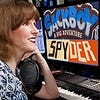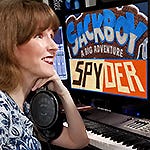
Featured Blog | This community-written post highlights the best of what the game industry has to offer. Read more like it on the Game Developer Blogs or learn how to Submit Your Own Blog Post
Variation for the video game composer: the music of Little Lords of Twilight
Theme and variation in video game music is useful in creating differentiation that facilitates gamer comprehension of design mechanics. Video game composer Winifred Phillips describes how she used variation for her Little Lords of Twilight game score.


By Winifred Phillips | Contact | Follow
Since one of my most recent projects, Little Lords of Twilight, became available worldwide earlier this year and was recently greenlit on the famous Steam platform, I thought I'd write this article to share some of my creative and technical process in composing the music for this game. In particular, this project presents a great opportunity to look at how compositional variation (as we understand it from music theory) can be useful for the structure of interactive music.
Developed by BKOM Studios, Little Lords of Twilight won a Best in Play Award at GDC 2017, a Best Designed Mobile App Platinum Award from the BMA Awards, a Communicator Award for Best Mobile App, and has appeared on numerous "Best of" lists, including those published by PocketGamer, Explore Gadgets, and GameInOnline. As a player-versus-player turn-based strategy game, Little Lords of Twilight offers a unique gameplay mechanic influenced by the in-game passage of time. Day and night cycles dramatically alter your character's appearance and abilities. Depending on whether it is currently day or night in the game, your character will have access to a completely different complement of awesome skills and spells to wield on the battlefield.
 I first encountered Little Lords of Twilight on the show floor of the popular Electronic Entertainment Expo last year. After being thoroughly charmed by the game's art style and intrigued by its mechanics, I had the chance to meet with the BKOM Studios representative at the booth and talk about music needs for the game. The timing couldn't have been better. That initial conversation led to more in-depth talks with more members of the development team over the ensuing weeks, and I was subsequently hired to create the music of the Little Lords of Twilight game. So, I suppose the lesson here is that we game composers can never be sure when opportunity will present itself, but the E3 convention seems to be a good place to go looking for it!
I first encountered Little Lords of Twilight on the show floor of the popular Electronic Entertainment Expo last year. After being thoroughly charmed by the game's art style and intrigued by its mechanics, I had the chance to meet with the BKOM Studios representative at the booth and talk about music needs for the game. The timing couldn't have been better. That initial conversation led to more in-depth talks with more members of the development team over the ensuing weeks, and I was subsequently hired to create the music of the Little Lords of Twilight game. So, I suppose the lesson here is that we game composers can never be sure when opportunity will present itself, but the E3 convention seems to be a good place to go looking for it!
 The expert development team of Little Lords of Twilight were interested in a musical style that would feel simultaneously adventurous, whimsical and sinister. So, let's first listen to my Little Lords of Twilight main theme music, which was designed to express the musical style of the game as succinctly and iconically as possible. Here's a video that shows how a player encounters the main theme music while navigating the game's menu system. Notice the whimsical celeste and glockenspiel on top, the adventurous orchestral strings and brass underneath, and the darkly sinister timpani, theremin and sound design rounding out the mix.
The expert development team of Little Lords of Twilight were interested in a musical style that would feel simultaneously adventurous, whimsical and sinister. So, let's first listen to my Little Lords of Twilight main theme music, which was designed to express the musical style of the game as succinctly and iconically as possible. Here's a video that shows how a player encounters the main theme music while navigating the game's menu system. Notice the whimsical celeste and glockenspiel on top, the adventurous orchestral strings and brass underneath, and the darkly sinister timpani, theremin and sound design rounding out the mix.
While the main theme sets the general mood of the game, the atmosphere of the gameplay in Little Lords of Twilight is much more intense and determined. To get a sense of how gameplay proceeds, here's the trailer for Little Lords of Twilight, featuring music I composed for the game:
You'll notice that the trailer highlights the game's most distinguishing play mechanic - the power of day and night to bring about change in the characters' appearances and abilities. For most of the pieces I composed for Little Lords of Twilight, I was asked to musically execute this abstract idea of fundamental change between the innate nature of day and night in the game's magical world. The interactive music system of Little Lords of Twilight hinged on the changeover from day into night and vice versa. The music for these two gameplay states needed to transition well into each other, and yet convey distinctly different atmospheres. Let's take a look at a couple of levels from the Little Lords of Twilight game to see how this worked.
Day and night in the forest
The music of the forest in the daytime is driven by a moderate tempo and a 3/4 time signature that gives the music its whimsical touch, accented by plentiful bells and harps to further enhance the effect. The string section states a repeating rhythmic motive right from the start and continues to emphasize this same pattern throughout the piece. The composition goes through several melodic sections with chord progressions that create forward momentum from one musical idea to the next. When I was composing this track for Forest Day, I had in my mind that for the Forest Night track, I wanted to use a recognizably familiar variation on the same rhythmic motive, along with variations on melodic sections and chord progressions that had already been heard in Forest Day. However, it was very important that the contrast between the two tracks made itself readily apparent to the listener. Let's first listen to the Forest Day track in its entirety:
Now, let's turn our attention to Forest Night. Unlike Forest Day, the music for Forest Night is in the common time signature, although the tempo is still moderately paced. Xylophone, theremin and frequent tremolo strings emphasize the sinister, gothic nature of nighttime in Little Lords of Twilight. Listening carefully, however, we'll notice that variations on the same rhythmic motives, melodic sections and chord progressions from Forest Day are present in the compositional structure of Forest Night. These elements also occur in the same order in which they previously appeared during the daytime music. Let's now listen to the Forest Night track:
Okay, so we've listened to the two tracks. Now let's see how they worked in the game. Notice the transition from day to night at 0:26 seconds:
Let's now see how this same principle worked in a very different level of the Little Lords of Twilight game.
Day and night in the Underground
By the time the player has reached the Underground, the intensity of gameplay has increased considerably, and the music also grows more correspondingly anxious. Like the music for Forest Day, the music for Underground Day incorporates a meter and rhythm that focuses on threes. In the forest, the music is written in a classic waltz-like triple meter (3/4). In the Underground, however, the music is written in an unusual compound meter, in which there are nine beats per measure, with each beat divided into three parts. The bassline in this track is the most characteristically iconic element of the music, with its insistently repetitive structure creating the forward momentum of the track. This momentum builds towards a chord modulation in a new section midway through, which also introduces a plaintive high-pitched melody line. When composing this track for Underground Day, I knew it would be important to retain all of these musical elements in the nighttime track and execute them in a way that created contrast while still retaining familiarity. So let's listen first to the Underground Day track:
For Underground Night, I retained the focus on nine beats per measure, although the compound meter is now simplified to a more traditional rhythmic structure (each beat divided into two parts rather than three). The tempo in Underground Night is now greatly accelerated, which helps to indicate the higher stakes of gameplay at this point in the game. Despite these differences, we'll notice that the same bassline from Underground Day is now forming the backbone of Underground Night, along with a melody line that is a variation and development of the plaintive melody from Underground Day. Let's listen to how these elements worked together in the music for Underground Night:
Finally, let's see how both of these tracks worked in the game. As sometimes happens in the game, in this video you'll notice that gameplay begins in the nighttime state, and then transitions into day. Notice the transition from night to day that occurs at 0:32:
Conclusion
In this article, we've explored how musical variation can be used to make interactive music transitions more impactful, while still retaining a distinct musical identity for specific locations within a game. I hope you've found this discussion of the music of Little Lords of Twilight interesting! Thanks for reading, and please let me know your thoughts in the comments section below!
 Winifred Phillips is an award-winning video game music composer whose most recent projects include the triple-A first person shooter Homefront: The Revolution and the Dragon Front game for Oculus VR. Her credits include games in five of the most famous and popular franchises in gaming: Assassin’s Creed, LittleBigPlanet, Total War, God of War, and The Sims. She is the author of the award-winning bestseller A COMPOSER'S GUIDE TO GAME MUSIC, published by the MIT Press. As a VR game music expert, she writes frequently on the future of music in virtual reality games.
Winifred Phillips is an award-winning video game music composer whose most recent projects include the triple-A first person shooter Homefront: The Revolution and the Dragon Front game for Oculus VR. Her credits include games in five of the most famous and popular franchises in gaming: Assassin’s Creed, LittleBigPlanet, Total War, God of War, and The Sims. She is the author of the award-winning bestseller A COMPOSER'S GUIDE TO GAME MUSIC, published by the MIT Press. As a VR game music expert, she writes frequently on the future of music in virtual reality games.
Follow her on Twitter @winphillips.
About the Author(s)
You May Also Like







.jpeg?width=700&auto=webp&quality=80&disable=upscale)








